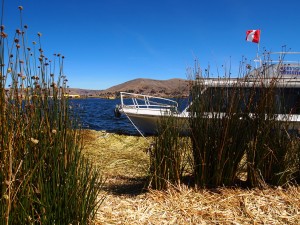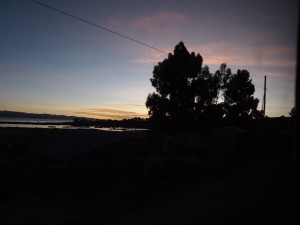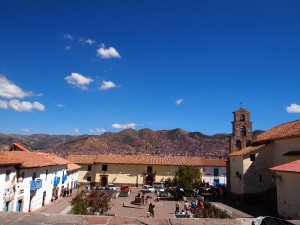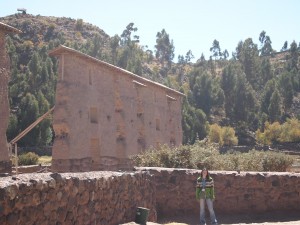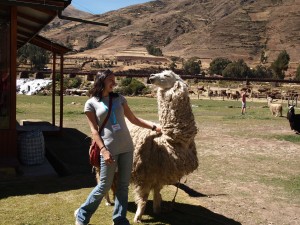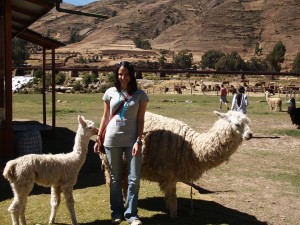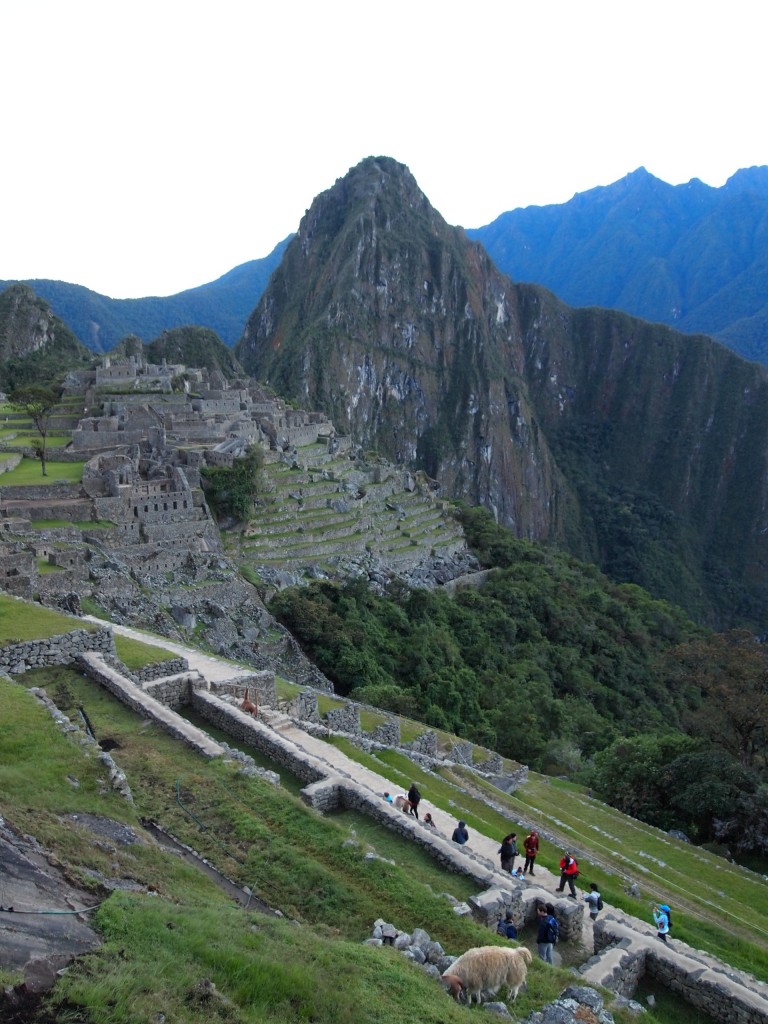Everyone hears Copacabana and automatically things Brazil, but the Copacabana I was in is actually a tiny tourist city on the shore of Lake Titicaca, right on the border of Peru and Bolivia.
On my full day in this beach town, I decided to take a day trip out to Isla de Sol. Though I’d seen the floating islands in Puno, I’d heard and read about Isla de Sol as a completely different experience — its scenery makes you feel as though you’re on a greek island, until you see the view of the snow capped mountains over the ocean. Boats leave Copacabana at 8:30 AM and take 2 1/2 hours to arrive at the northern tip of the Isla de Sol so I was up at 6:45 to shower (with hot water and good water pressure, totally worth the splurge on my fancy hotel!) and grab breakfast as soon as my hotel restaurant opened at 7:30 AM. For 59 Bolivianos, about $8.50, I got a cafe con leech, an egg scramble with cheese, olives, onions and tomatoes, wheat bread, and a “boxed lunch” which included a sandwich, drinkable yogurt, apple, chips, chocolate bar and water bottle. Bolivia is so damn cheap!
I walked the five minutes down to the beach to catch the boat, which cost me 30 bolivianos (just over $4) for a round trip ticket. The ride to the northern part of the Island was long and cold, and there was a group of a few very loud portuguese-speaking folks who were way too loud for 9 AM in the middle of a lake. I sat next to a nice German guy named Martin, and in between attempting to sleep, we had some good conversation. He, like most people making the trip, was going to spend the night on the island at one of the many basic, but cheap, hostels. Unfortunately, since I had already booked my hotel and didn’t have more than a day and a half in Copacabana, I didn’t have time to take more than a day trip. When you go for the day, most tourists walk the 8 km from the northern tip to the southern port, where you can catch the last boat back to Copacabana at 3:30 PM.
Once we got off the boat I quickly discovered there was nobody at the tourist office who spoke a word of English. Thankfully, a super sweet French-Canadian guy who spoke some Spanish helped me translate, and pointed me in the right direction of the boleto (ticket) office and the walk I wanted to do. He was traveling with a friend and his older sister, and the four of us ended up doing the majority of the 3-4 hour walk from the north of the island to the south together.
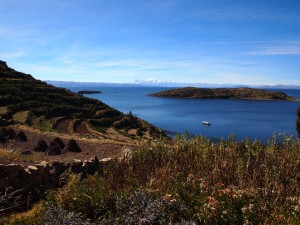 When I read on trip advisor that some of the walk would take your breath away, I had no idea that actually meant that the walk was full of steep paths up multiple hills. There were (many) moments where I was cursing my decision to do the walk, at the same time barely able to catch my breath. Even though the altitude in Cusco is similar to the altitude in Copacabana, it seems to be affecting me a lot more down here — I’m out of breath so much more than I was on my trek, and I did ten times the amount of walking in Peru!
When I read on trip advisor that some of the walk would take your breath away, I had no idea that actually meant that the walk was full of steep paths up multiple hills. There were (many) moments where I was cursing my decision to do the walk, at the same time barely able to catch my breath. Even though the altitude in Cusco is similar to the altitude in Copacabana, it seems to be affecting me a lot more down here — I’m out of breath so much more than I was on my trek, and I did ten times the amount of walking in Peru!
The first forty five minutes of the walk was uphill to a section of runs which, to say the least, were quite unimpressive. Maybe because I just saw such spectacular Inca buildings up north in Peru, but the measly wall we had walked to was definitely not worth the extra time. Oh well!
The rest of the walk was beautiful, but because the four of us were a bit concerned about making it across the island before 3:30, we did it quite quickly. It was nice to have people to push me along, since there were certainly points where I would have stopped, or simply collapsed! It was also nice to have company and conversation, even if I did have a hard time understanding their Québécois English!
Along the way, there were several checkpoints where you had to pay 10 or 15 bolivianos to pass. I’d read about this in my guidebook and was warned at my hotel, but most people doing the walk didn’t realize and were relatively unhappy about having to fork over the extra cash. It seemed silly to be upset about forking over a dollar or two, I was happy to support the locals, and in the scheme of this trip, a few dollars seemed like nothing. It was disappointing to hear so many grumbles, instead of willingness to support the locals and such a beautiful island.
Once we reached the southern part of the island, I was relatively close to wanting to pass out. I hadn’t eaten in several hours but luckily had my very cheap boxed lunch, so while the group of Canadians continued walking to a section of restaurants, I took a seat on a shaded concrete staircase with a beautiful view of the lake and ate my sandwich (which, unfortunately, turned out to consist mostly of a disgusting mystery cheese, so I mostly ate the bread, tomato and cucumber). While I was sitting, another group of English-speakers (two English guys and a girl from Iceland) passed and started talking to me about the unimpressive ruins we’d seen on the beginning of the walk. I gave up my seat and walked the rest of the way to the harbor with them, a good distraction since we had to make our way down some seriously steep, rocky stairs. One thing is for sure: I’ve had enough with the narrow, steep stairs!
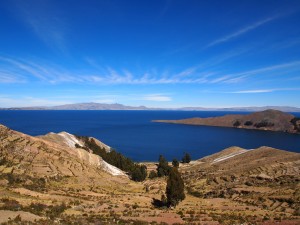 My new friends didn’t bring lunch with them, so I sat with them at a restaurant and shared some of my trail mix (Trader Joe’s cran-almond-cashew mix shlepped all the way from Boston — so worth it in that moment) while they ate their over-priced and unimpressive pollo sandwiches.
My new friends didn’t bring lunch with them, so I sat with them at a restaurant and shared some of my trail mix (Trader Joe’s cran-almond-cashew mix shlepped all the way from Boston — so worth it in that moment) while they ate their over-priced and unimpressive pollo sandwiches.
Then came the boat ride from hell. Okay, I exaggerate. But between the harsh rocking of the very small boat, the loud talking of everyone around me, and the very harsh, hot sun beating down intensely on the back of my head and neck, I was not a happy camper. The ride back to Copacabana was only an hour and a half, but by the end I was seriously convinced I was going to hurl out of the side of the boat. Luckily I didn’t, and was able to (somehow) stumble up the stairs from the beach and back to my hostel to sleep off the nausea. My plan was to nap for an hour and a half and then sit in the TV room of my hotel with my laptop and catch up on blogging, eat some dinner and relax. Instead, I woke up at 10:30 PM completely confused, and soon realized the restaurant was closed and I couldn’t get dinner. So instead, I changed into sweats and passed back out. I woke up in a cold sweat at 5 AM from a dream that I’d somehow misunderstood the time of my bus down to La Paz and therefore missed my only chance out of Copacabana. So unrealistic, but definitely not a fun way to wake up!
I slept on and off for the next two hours, then woke myself up to triple check the time of my bus (13:00 PM, just as I had thought, but I’m consistently paranoid about misreading 24 hour time). I also realized that on my paperwork, the company I had booked with said I should have a voucher ticket in my email, which I of course never received. So I spent the first hour and a half of my day emailing/chatting them, trying to get the voucher and figure out if I needed to print it. I also made a friend while I sat in the kitchen eating my leftover breakfast from yesterday: an orange cat who decided her new favorite spot was my lap, and absolutely refused to move from her spot on my thighs no matter what I did. She kept me warm though, so I didn’t complain, at least not until she started crawling all over my keyboard in an attempt to snag some of my breakfast.
After I got my voucher situation sorted out, I checked out of my room, stuck my stuff in storage and made my way “downtown.” Copacabana itself is a relatively unimpressive town — it’s on the lake and nestled between two mountains so the scenery is great, but the actual town leaves something to be desired. Similar to Puno, it’s very hilly and mostly filled with hostels, hotels, and tourist “pizzeria” restaurants everywhere you turn. It was, however, a perfect picturesque place to do some relaxing (or in my case, lots of sleeping) without feeling like you’re missing anything. I did some wandering and considered making my way up one of the very steep mountains to some ruins, but the combination of feeling short of breath from the altitude, realizing how sore my legs were from the walk yesterday, and simply looking up the path, I decided to just appreciate them from the base of the hill. During my wandering, I happened upon a concrete plaza with a small church, which actually had some really beautiful views of the lake and town, so sat in the shade and talked to a guy from Rhode Island whose wife, from Boston, was making her way to the top of the lookout.
From there I went to a small, ex-Pat run cafe and got a deliciously sweet banana milkshake and some eggs, then walked back to my hotel to grab my bags and get a taxi to the bus station.
Turns out the “bus station” I thought I was going to was actually just a small storefront, where Vicuna Tours has their office. I was told specifically to arrive at least 30 minutes prior to the departure of my 1 PM bus, but I sat in an empty office between 12:25 and 12:45 until someone finally showed up to check my ticket. Naturally, since I was there so early, our bus didn’t actually leave Copacabana until closer to 1:30. I’m learning this is very typical — South American time is something else!
About an hour into our bus ride, the driver’s assistant came into the back of the bus (the bus has a separate front section for the driver and front passenger with a door to the main cabin of the bus) and made an announcement in Spanish. My paranoid self decided he was saying that the bus wasn’t working properly (I’d seen them fiddling with the engine while I was patiently waiting to board at the office in Copacabana) and that we needed to buy a ticket for another bus. Thankfully, the nice American man sitting next to me translated and explained that we had to get off the bus to buy a ferry ticket across the lake. Uhm, what?
Turns out there is no bridge across the lake, and the only way to cross is by tiny motor boat. Meanwhile, the busses are boated across on wide, wooden platform boats that look like they’re going to spring a leak and sink into the lake at any moment.
Silly me, I had sworn to myself that I wouldn’t get on another boat this trip. Little did I know…
This boat ride was also rather rocky and nausea-inducing, luckily it was only a 7 minute trip to the other side. From the shore, I watched our bus teeter its way across on its own ship, convinced at any minute it was going to topple into the lake. Once our bus (miraculously) made it across 15 minutes later, we hopped back on and were on our way. I didn’t ask the obvious question to anyone I interacted with during that half an hour excursion, but all I can think, to this day, is “Why don’t they build a damn bridge?”
The bus dropped us off in La Paz on a random street corner, handed us our luggage and disappeared. I, along with many of the other passengers, were totally confused and had read lots of things about the dangers of taking unofficial taxis in Bolivia, so a couple from London and I finally flagged down a Radio taxi that we shared to the other side of town where we were all staying.
Once I got to my hostel in La Paz it was already 7 PM and I was unmotivated to wander the city past dark on my own. I was relatively exhausted and happy to have a regular, working wifi connection, so I stayed in, caught up on blogging and sorting through my photos, ordered a caprese sandwich from the bar and called it a night!

